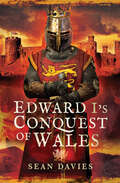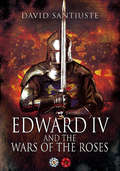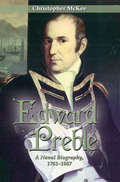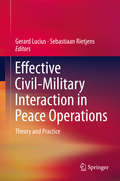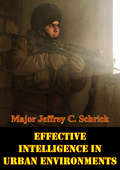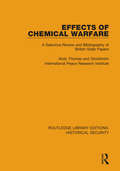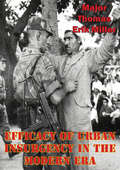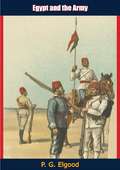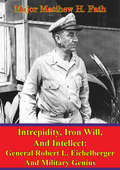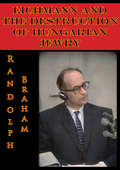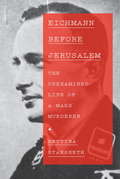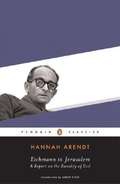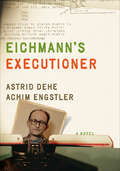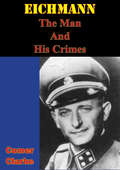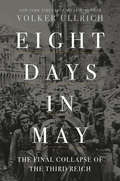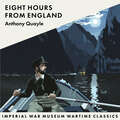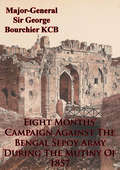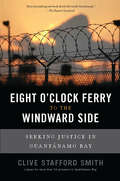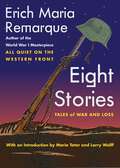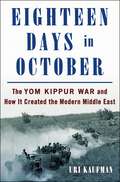- Table View
- List View
Edward I's Conquest of Wales
by Sean DaviesA study of medieval warfare and a formative event in the history of Britain. Edward I&’s conquest of Wales has not been the subject of a scholarly book for over a century. Research has advanced since then, changing our perception of the medieval military mind and shining fresh light on the key characters involved in the conquest. That is why Sean Davies&’s absorbing new study is so timely and important. Taking a balanced approach, he gives both the Welsh and English perspectives on the war and on the brutal, mistrustful, and ruthless personal motives that drove events. His account is set in the context of Welsh warfare and society from the end of Rome to the time of Edward&’s opening campaign in the late thirteenth century. The narrative describes in vivid detail the military history of the conflict; the sequence of campaigns; Welsh resistance; Edward&’s castle building and English colonization; the cost of the struggle to the Welsh and the English; and the uneasy peace that followed.
Edward III and the Triumph of England: The Battle of Crécy and the Company of the Garter
by Richard BarberA fascinating recreation of the world of one of England's most charismatic monarchs, from award-winning author and historian Richard BarberThe destruction of the French army at Crécy in 1346 and the subsequent siege and capture of Calais marked a new era in European history. The most powerful, glamorous and respected of all western monarchies had been completely humiliated by England, a country long viewed either as a chaotic backwater or a mere French satellite.The young Edward III's triumph would launch both countries, as we now know, into a grim cycle of some 90 years of further fighting ending with English defeat, but after Crécy anything seemed possible - Edward's claim to be King of France could be pressed home and, in any event, enormous rewards of land, treasure and prestige were available both to the king and to the close companions who had made the victory possible. It was to enshrine this moment that Edward created one of the most famous of all knightly orders, the Company of the Garter.Barber writes about both the great campaigns and the individuals who formed the original membership of the Company - and through their biographies makes the period tangible and fascinating. This is a book about knighthood, battle tactics and grand strategy, but it is also about fashion, literature and the privates lives of everyone from queens to freebooters. Barber's book is a remarkable achievement - but also an extremely enjoyable one.Reviews:'Barber [has an] infectious passion for and deep knowledge of his subject matter ... elegant prose and rigorous historical analysis ... a valuable and thorough addition to the body of work on this most impressive of English monarchs' Sunday Times'In Edward III and the Triumph of England [Barber] has written the kind of book that the king would have enjoyed: full of battles, glitter and ceremony ... he has an original eye and an elegant pen' Jonathan Sumption, Literary Review'Barber share's his hero's love of chivalry ... The book sparkle[s] with some of Edward's own glitz' Telegraph'This absorbing book is layered rather than linear, sifting with uncommon sensitivity through challenging sources to test the boundaries of what we can and cannot know ... We discover the complexity of the world in which Edward and his commanders lived' Helen Castor, The TimesAbout the author:Richard Barber has had a huge influence on the study of medieval history and literature, both as a writer and as a publisher. His major works include The Knight and Chivalry (winner of the Somerset Maugham Award), Edward Prince of Wales and Aquitaine, The Penguin Guide to Medieval Europe and The Holy Grail: The History of a Legend. He lives in East Anglia.
Edward IV and the Wars of the Roses
by David SantiusteThis fascinating account of an unsung English monarch and military leader is &“a pleasing and well-informed appraisal of the first Yorkist king&” (Dr. Michael Jones, author of Bosworth 1485: Psychology of a Battle). Indisputably the most effective general of the Wars of the Roses in fifteenth-century England, King Edward IV died in his bed, undefeated in battle. Yet he has never been accorded the martial reputation of other English warrior kings such as Henry V. It has been suggested that perhaps he lacked the personal discipline expected of a truly great army commander. But, as the author shows in this perceptive and highly readable new study, Edward was a formidable military leader whose strengths and subtleties have never been fully recognized—perhaps because he fought most of his battles against his own people in a civil war. This reassessment of Edward&’s military skill—and of the Wars of the Roses in which he played such a vital part—provides fascinating insight into Edward the man as well as the politician and battlefield commander. Based on contemporary sources and the latest scholarly research, Edward IV and the Wars of the Roses stands as &“a valuable and thought-provoking addition to the canon, which ought to become required reading for anyone interested in the reign of the first Yorkist monarch&” (The Ricardian).
Edward Preble
by Christopher MckeeOriginally published in 1972, Christopher McKee's biography of Edward Preble remains the most authoritative source on this influential early shaper of the U.S. naval tradition. McKee (Grinnell College) documents Preble's rise from obscurity to become Thomas Jefferson's chief administrator, his relationship with Jefferson and the president' policies and strategies during the war, and also the Tripolitan activities and attitudes which confronted Preble as he sought to bring the war to an end. This Classic of Naval Literature work includes illustrations and a new introduction by the author.
Edwardian Ladies' Hat Fashions: Where Did You Get That Hat? (Images Of The Past Ser.)
by Peter KimptonBased upon the authors large personal collection of beautiful fashion postcards from Edwardian times, this book takes the reader on a journey through that era covering the hat fashions and social changes of the day. Delve further into the carnage that took place around the world, in which unscrupulous and money grabbing individuals from the Northumbrian coast in England to the Everglades in America, would callously slaughter whole colonies of birds (leaving their young to die) purely to provide the millinery trade with ornate feathers to decorate fashionable hats during that era.The book also takes the reader into the world of millinery sweatshops of poverty stricken New York and describes the conditions and deprivations under which the poorly paid workers, many of them immigrants, worked. You can even learn about the background, history and amazing life of one of the worlds greatest fashion designers, Coco Chanel, as she set out on her lifetime of fashion in Edwardian Paris.With superb fashion colour plates of the day, together with images of amazingly creative and colourful hat pins from both the UK and America, the author shares the fruits of his 40 years of postcard collecting and the highs and lows of his search for the 'Hats' postcards, as worn by his Edwardian 'girlfriends' from over 100 year ago.
Effective Civil-Military Interaction in Peace Operations
by Sebastiaan Rietjens Gerard LuciusThis book contains unique, firsthand experiences of both the military and civilian actors involved in civil-military interaction processes. It presents lessons learned from a variety of situations, from both NATO-led operations and UN Integrated Missions, and in different geographical areas, such as the Balkans, Iraq, Afghanistan and Africa. Rather than taking the improvisational approach, these lessons learned will enable military commanders and staff and their civilian counterparts in governments, International Organisations and NGOs to come fully prepared for the challenges of today's multifaceted missions. With a better understanding of the mandates and methods of the various civilian and military actors comes greater respect for each other's comparative advantages. With respect comes smoother cooperation. And with that, efficiency gains and enhanced overall mission effectiveness. Each chapter contains solid analysis and advice, specific to the functions found in military organizations, from Intelligence to Personnel and from Logistics to Engineering. Cross-cutting themes like Gender, Human Rights and Corruption are also included in this work that brings together some of the best that practitioners and academics can offer.
Effective Intelligence In Urban Environments
by Major Jeffrey C. SchrickThis thesis analyzes the intelligence collection and dissemination in urban environments at the maneuver battalion. The methodology attempts to assess the organic intelligence assets and capabilities within a maneuver battalion, the training of the maneuver battalion officers on the employment of intelligence assets, and the availability of doctrinal literature about urban operations. The war in Iraq presents the Army with an operational environment that is unfamiliar to a force that has trained for conventional warfare in open terrain. The commanders, especially at battalion level and below, need an efficient and effective intelligence system.The focus of the research will be on the shortcomings and solutions for the intelligence systems supporting operations at the tactical level. The FM 3-0, Operations, dated February 2008, is the capstone doctrine for the U.S. Army for the current operations in Iraq and Afghanistan and for future prolonged conflicts as an expeditionary force. Discussion among the maneuver and intelligence communities on how to improve the intelligence collection and dissemination in urban environments is worthy of research. The historic perspective of the urban environment complexities and their military significance provide lessons learned on how military intelligence plays an important role in successful operations in such terrain.
Effects of Chemical Warfare: A Selective Review and Bibliography of British State Papers (Routledge Libary Editions: Historical Security)
by Andy Thomas Stockholm International Peace Research InstituteOriginally published in 1985, this book is the result of an exploration of the state papers of the United Kingdom undertaken with the aim of discovering information about the past use of chemical warfare. This information may serve as a point of historical reference in speculation upon the possible nature and consequences of large-scale chemical warfare recurring in Europe. Part I of the monograph concentrates primarily on material documenting the use of chemical weapons in the First and Second World Wars, the impact of this use on the civilian populations of France and Belgium, casualties incurred in the production, research, development, training and deployment of chemical warfare agents, and the attempts made to incorporate chemical weapons into military doctrine and war-preparedness. Part II supplements the citation of documents in Part I. It comprises an ordered bibliography listing not only the location of the records found to be of primary concern to this study, but also the location of other records not cited in Part I which appear to form much of the remainder of the official record of the British CW effort. A list of some of the papers which have not been released comprises the concluding section.
Efficacy Of Urban Insurgency In The Modern Era
by Major Thomas Erik MillerInsurgency is one of the oldest and most prevalent forms of warfare. The last fifty years have seen the increase in the numbers and intensity of insurgencies worldwide, particularly in urban insurgencies. Global trends of virtually unconstrained population growth and urbanization (particularly in underdeveloped countries), globalization and the information revolution create conducive environments for urban insurgency.The approach taken in this thesis is to examine three exemplar case studies to determine causation in the outcome of the urban insurgencies, their purposes, differences in technique between rural and urban insurgency, the advantages and disadvantages of the urban insurgent, and whether these advantages were capitalized upon in order to determine the feasibility of urban insurgency in the modern era. The case studies examined were the Battle of Algiers from 1956 to 1957, Uruguay from 1962 to 1972, and Northern Ireland from 1969 to 1974.The conclusion of this work is the feasibility of modern urban insurgency. Urban insurgents will apply modern technologies to enhance their security, use discriminate targeting, especially in economic targeting, and skillfully conduct information operations in exploitation of the media and technologies for dissemination. Counterinsurgents must win the information war and execute a coherent strategy addressing the underlying cause of insurgency to prevail.
Ego-histories of France and the Second World War: Writing Vichy (The\holocaust And Its Contexts Ser.)
by Manuel Bragança Fransiska LouwagieThis volume presents the intellectual autobiographies of fourteen leading scholars in the fields of history, literature, film and cultural studies who have dedicated a considerable part of their career to researching the history and memories of France during the Second World War. Basedin five different countries, Margaret Atack, Marc Dambre, Laurent Douzou, Hilary Footitt, Robert Gildea, Richard J. Golsan, Bertram M. Gordon, Christopher Lloyd, Colin Nettelbeck, Denis Peschanski, Renée Poznanski, Henry Rousso, Peter Tame, and Susan Rubin Suleiman have playeda crucial role in shaping and reshaping what has become a thought-provoking field of research. This volume, which also includes an interview with historian Robert O. Paxton, clarifies the rationales and driving forces behind their work and thus behind our current understanding of one of the darkest and most vividly remembered pages of history in contemporary France.
Egypt 1801: The End of Napoleon's Eastern Empire
by Stuart ReidThe first campaign medal awarded to British soldiers is reckoned to be that given to those men who fought at Waterloo in 1815, but a decade and a half earlier a group of regiments were awarded a unique badge – a figure of a Sphinx - to mark their service in Egypt in 1801. It was a fitting distinction, for the successful campaign was a remarkable one, fought far from home by a British army which had so far not distinguished itself in battle against Revolutionary France, and one moreover which had the most profound consequences in the Napoleonic wars to come. In 1798 a quixotic French expedition led by a certain General Bonaparte not only to seize Egypt and consolidate French influence in the Mediterranean, but also to open up a direct route to Indian and provide an opportunity to destroy the East India Company and fatally weaken Great Britain. In the event, General Bonaparte returned to France to mount a coup which would eventually see him installed as Emperor of the French, but behind him he abandoned his army, which remained in control of Egypt, still posing a possible threat to the East India Company, until in 1801 a large but rather heterogeneous British Army led by Sir Ralph Abercrombie landed and in a series of hard-fought battles utterly defeated the French. Not only did this campaign establish the hitherto rather doubtful reputation of the British Army, and help secure India, but its capture en route of the islands of Malta gained Britain a base which would enable it to dominate the Mediterranean for the next century and a half. This little understood, but profoundly important campaign at last receives the treatment it deserves in the hands of renowned historian Stuart Reid.
Egypt and the Army
by P. G. ElgoodIn his 1924 book, Egypt and the Army, author P. G. Elgood demonstrated his intimate knowledge and reasoned criticism of the conditions and circumstances which brought the Egyptian Army into being from 1882 onwards, and resulted in the creation of a reliable fighting force when trained and disciplined by carefully selected British officers.An invaluable addition to any History library.
Eichelberger - Intrepidity, Iron Will, And Intellect: General Robert L. Eichelberger And Military Genius
by Major Matthew H. FathThere are currently two contradictory schools of thought in the historiography of General Robert L. Eichelberger's generalship. One group of authors, John Shortal and Jay Luvaas, consider Eichelberger a brilliant World War II commander. Another author, Paul Chwialkowski, believes Eichelberger to be good, but not distinguished. This study attempts to develop a concise judgment of Eichelberger's leadership. The research analyzed Eichelberger's generalship using Clausewitz's theory of military genius as a model. The first step was to define military genius and to determine its components and subcomponents. Next, Eichelberger's pre-World War II education, mentorship, and training experiences were evaluated. The third step was to analyze Eichelberger's generalship during the Papua New Guinea, Netherlands New Guinea, and Philippines Campaigns of World War II to determine if he consistently demonstrated the qualities of military genius. This study concluded that Eichelberger definitively displayed the components of courage and determination but a judgment on his coup d'œil required a more detailed examination and warranted further research. Eichelberger's leadership is relevant to today's military officer because he successfully defeated an enemy who employed many asymmetrical tactics of potential enemies in the contemporary operating environment: anti-access denial, defense in complex terrain, and fanatical fighting abilities.
Eichelberger In Mindanao: Leadership In Joint Operations
by LTC Dan K. McNeillGeneral Robert L. Eichelberger was an extraordinary and brilliant leader. He was a selfless man who loyally and diligently served an egocentric task maker in General Douglas MacArthur. Eichelberger was the American version of the British Field Marshal William Slim of Burma fame. In a six-month period in World War II, Eichelberger's Eighth US Army made 52 amphibious landings in the Southwest Pacific Theater. In each of those operations, Eichelberger skillfully used US and Allied ground troops, naval forces, and aircraft. While his Army was normally assigned a supporting or mopping-up role, the Mindanao campaign was solely Eichelberger's. The purpose behind this study is to explore Eichelberger's leadership in the joint operations on, Mindanao Island in the Philippines.
Eichmann And The Destruction Of Hungarian Jewry
by Randolph L. BrahamThe capture of Adolf Eichmann and the subsequent dispute between Israel and Argentina before the Security Council of the United Nations have aroused new interest in the history of Nazi Germany in general and of its anti-Jewish policies in particular. This interest gained momentum as the preparations for Eichmann's trial progressed.The 15 years that have elapsed since the end of World War II have brought to light a plethora of new material and made possible a more objective evaluation of the Nazi design to liquidate the Jews of Europe, euphemistically referred to as "the final solution of the Jewish question."This study has a modest aim. Its primary purpose is to present a succinct, though informative, account of the destruction of the Hungarian Jewish community during World War II, with special emphasis on the role of Eichmann and his collaborators. Its scope and coverage are limited, for, indeed, volumes would be required to write the definitive history of Hungarian Jewry during the Nazi era on the basis of the recently discovered documentary and archival material alone. Such a larger project is now under consideration.-Preface
Eichmann Before Jerusalem: The Unexamined Life of a Mass Murderer
by Ruth Martin Bettina StangnethA total and groundbreaking reassessment of the life of Adolf Eichmann—a superb work of scholarship that reveals his activities and notoriety among a global network of National Socialists following the collapse of the Third Reich and that permanently challenges Hannah Arendt’s notion of the “banality of evil.”<P> Smuggled out of Europe after the collapse of Germany, Eichmann managed to live a peaceful and active exile in Argentina for years before his capture by the Mossad. Though once widely known by nicknames such as “Manager of the Holocaust,” in 1961 he was able to portray himself, from the defendant’s box in Jerusalem, as an overworked bureaucrat following orders—no more, he said, than “just a small cog in Adolf Hitler’s extermination machine.” How was this carefully crafted obfuscation possible? How did a central architect of the Final Solution manage to disappear? And what had he done with his time while in hiding?<P> Bettina Stangneth, the first to comprehensively analyze more than 1,300 pages of Eichmann’s own recently discovered written notes— as well as seventy-three extensive audio reel recordings of a crowded Nazi salon held weekly during the 1950s in a popular district of Buenos Aires—draws a chilling portrait, not of a reclusive, taciturn war criminal on the run, but of a highly skilled social manipulator with an inexhaustible ability to reinvent himself, an unrepentant murderer eager for acolytes with whom to discuss past glories while vigorously planning future goals with other like-minded fugitives. <P> A work that continues to garner immense international attention and acclaim, Eichmann Before Jerusalem maps out the astonishing links between innumerable past Nazis—from ace Luftwaffe pilots to SS henchmen—both in exile and in Germany, and reconstructs in detail the postwar life of one of the Holocaust’s principal organizers as no other book has done.
Eichmann in Jerusalem: A Report on the Banality of Evil
by Hannah ArendtHannah Arendt's authoritative report on the trial of Nazi leader Adolf Eichmann includes further factual material that came to light after the trial, as well as Arendt's postscript directly addressing the controversy that arose over her account.
Eichmann's Executioner: A Novel
by Astrid Dehe Achim EngstlerThis acclaimed novel imagining the life of Israeli soldier Shalom Nagar explores the legacy of the Holocaust: &“A fascinating book that doesn&’t let you go&” (Neue Deutschland, Germany). In May 1962, twenty-two men gathered in Jerusalem to decide by lot who would be Adolf Eichmann&’s executioner. These men had guarded the former Nazi SS lieutenant colonel during his imprisonment and trial, and with no trained executioners in Israel, it would fall to one of them to end Eichmann&’s life. Shalom Nagar, the only one among them who had asked not to participate, drew the short straw. Decades later, Nagar is living on the outskirts of Tel Aviv, haunted by his memory of Eichmann. He remembers watching him day and night, the way he ate, the way he slept—and the sound of the cord tensing around his neck. But as he tells and re-tells his story to anyone who will listen, he begins to doubt himself. When one of his friends, Moshe, reveals his link to Eichmann, Nagar is forced to reconsider everything he has ever believed about his past. In the tradition of postwar trauma literature that includes Günter Grass&’s The Tin Drum and Bernhard Schlink&’s The Reader, Eichmann&’s Executioner raises provocative questions about how we represent the past, and how those representations impinge upon the present. &“Both curiously transparent and full of secrets, a simultaneously dense yet airy fabric of cryptic threads and references. . . . Nothing is gratuitous in this book, nothing coincidental; all is intricately interlaced.&” —Frankfurter Rundschau, Germany
Eichmann, The Man And His Crimes: The Man And His Crimes
by Comer ClarkeEichmann’s crimes, so monstrous that the first accounts were dismissed as anti-German propaganda, resulted in the death of 6,000,000 men, women and children. To maintain secrecy, the Nazis gave him the rank of sergeant at the very time when he was supervising the murder of Austria’s Jews. Speaking Yiddish fluently, Eichmann often disguised himself as a Jew and deceived Jewish leaders into giving him the names of his future victims. In his extermination camps, Jews were forced to aid in the slaughter of their people. To those who cooperated he promised “decent burial.” Human life meant nothing to Eichmann; instead, he prided himself on the efficient operation of his death camps and spent months searching for a low-cost poison for his gas chambers.Comer Clarke, British correspondent, has spent much of the last two years in Germany and Austria, questioning war criminals and men behind the Nazi plans and terror. He has had access to secret S.S. dossiers and Nazi documents captured after the war. He has met men who knew Eichmann intimately, and traced the Nazi butcher’s activities in a blood-stained trail of murder that leads across Europe. Out of his investigations he has written EICHMANN: THE MAN AND HIS CRIMES, a full account of Eichmann’s monstrous past, his mysterious disappearance.
Eight Days in May: The Final Collapse Of The Third Reich
by Volker UllrichThe best-selling author of Hitler: Ascent and Hitler: Downfall reconstructs the chaotic, otherworldly last days of Nazi Germany. In a bunker deep below Berlin’s Old Reich Chancellery, Adolf Hitler and his new bride, Eva Braun, took their own lives just after 3:00 p.m. on April 30, 1945—Hitler by gunshot to the temple, Braun by ingesting cyanide. But the Führer’s suicide did not instantly end either Nazism or the Second World War in Europe. Far from it: the eight days that followed were among the most traumatic in modern history, witnessing not only the final paroxysms of bloodshed and the frantic surrender of the Wehrmacht, but the total disintegration of the once-mighty Third Reich. In Eight Days in May, the award-winning historian and Hitler biographer Volker Ullrich draws on an astonishing variety of sources, including diaries and letters of ordinary Germans, to narrate a society’s descent into Hobbesian chaos. In the town of Demmin in the north, residents succumbed to madness and committed mass suicide. In Berlin, Soviet soldiers raped German civilians on a near-unprecedented scale. In Nazi-occupied Prague, Czech insurgents led an uprising in the hope that General George S. Patton would come to their aid but were brutally put down by German units in the city. Throughout the remains of Third Reich, huge numbers of people were on the move, creating a surrealistic tableau: death marches of concentration-camp inmates crossed paths with retreating Wehrmacht soldiers and groups of refugees; columns of POWs encountered those of liberated slave laborers and bombed-out people returning home. A taut, propulsive narrative, Eight Days in May takes us inside the phantomlike regime of Hitler’s chosen successor, Admiral Karl Dönitz, revealing how the desperate attempt to impose order utterly failed, as frontline soldiers deserted and Nazi Party fanatics called on German civilians to martyr themselves in a last stand against encroaching Allied forces. In truth, however, the post-Hitler government represented continuity more than change: its leaders categorically refused to take responsibility for their crimes against humanity, an attitude typical not just of the Nazi elite but also of large segments of the German populace. The consequences would be severe. Eight Days in May is not only an indispensable account of the Nazi endgame, but a historic work that brilliantly examines the costs of mass delusion.
Eight Hours From England: Imperial War Museum Wartime Classics
by Anthony QuayleAutumn 1943. Realising that his feelings for his sweetheart are not reciprocated, Major John Overton accepts a posting behind enemy lines in Nazi-Occupied Albania. Arriving to find the situation in disarray, he attempts to overcome geographical challenges and political intrigues to set up a new camp in the mountains overlooking the Adriatic.As he struggles to complete his mission amidst a chaotic backdrop, Overton is left to ruminate on loyalty, comradeship and his own future.Based on Anthony Quayle's own wartime experience with the Special Operations Executive (SOE), this new edition of a 1945 classic includes a contextual introduction from IWM which sheds new light on the fascinating true events that inspired its author.(P)2019 Headline Publishing Group Ltd
Eight Months’ Campaign Against The Bengal Sepoy Army During The Mutiny Of 1857 [Illustrated Edition]
by Major-General Sir George Bourchier KCB[Illustrated with over one hundred maps, photos and portraits, of the battles, individuals and places involved in the Indian Mutiny]"The Indian Mutiny from the siege of Delhi to the mutineers' defeat at Cawnpore, via the relief of Lucknow. Written by an officer of the British Horse Artillery.An account of the Indian Mutiny in 1857 by a British participant. The author, Col. Bourchier of the Bengal Horse Artillery, describes the British siege and storming of Delhi - including the foiling of a fiendish plan to intoxicate the besieging forces; the defeat of the mutineers at Agra; the siege and massacre at Cawnpore; the relief of Lucknow by Havelock and Outram and its second relief by Sir Colin Campbell; and finally the defeat of the Gwalior mutineers at Cawnpore. An action-packed account of eight months' of remorseless fighting."-Print Ed.
Eight O'Clock Ferry to the Windward Side: Seeking Justice in Guantánamo Bay
by Clive Stafford SmithEvery time human rights lawyer Clive Stafford Smith lands in Cuba, he takes the eight o'clock ferry to the windward side; his journey ends at Guantánamo Bay. One of the few people in the world who has ongoing independent access to the prison, Smith reveals the grotesque injustices that are perpetrated there in the name of national security-including the justifications created to legitimate the use of torture and the bureaucratic structures that have been put in place to shield prison authorities from legal accountability. <P><P>By bearing witness to the stories of the forty prisoners that he represents, Smith asks us to consider what is done to American democracy when the rule of law is jettisoned in the name of combating terrorism.
Eight Stories: Tales of War and Loss (Washington Mews #3)
by Erich Maria Remarque Maria Tatar Larry WolffA compelling set of short stories chronicling post-World War I life in Germany, from the author of the classic, All Quiet on the Western Front. German-American novelist Erich Maria Remarque captured the emotional anguish of a generation in his World War I masterpiece, All Quiet on the Western Front, as well as in an impressive selection of novels, plays, and short stories. This exquisite collection revives Remarque&’s unforgettable voice, presenting a series of short stories that have long ago faded from public memory. From the haunting description of an abandoned battlefield to the pain of losing a loved one in the war to soldiers&’ struggles with what we now recognize as PTSD, the stories offer an unflinching glimpse into the physical, emotional, and even spiritual implications of World War I. In this collection, we follow the trials of naïve war widow Annette Stoll, reflect on the power of small acts of kindness toward a dying soldier, and join Johann Bartok, a weary prisoner of war, in his struggle to reunite with his wife. Although a century has passed since the end of the Great War, Remarque&’s writing offers a timeless reflection on the many costs of war. Eight Stories offers a beautiful tribute to the pain that war inflicts on soldiers and civilians alike, and resurrects the work of a master author whose legacy—like the war itself—will endure for generations to come.
Eighteen Days in October: The Yom Kippur War and How It Created the Modern Middle East
by Uri Kaufman"[Kaufman] tells the story brilliantly. Anyone interested in the Middle East or military history will appreciate Kaufman’s work."—Senator Joseph I. Lieberman "Stimulating and insightful...will no doubt find a permanent place on the Arab-Israeli bookshelf."—Michael Oren, New York Times bestselling author of Six Days of WarOctober 2023 marks the 50th anniversary of the Yom Kippur War, a conflict that shaped the modern Middle East. The War was a trauma for Israel, a dangerous superpower showdown, and, following the oil embargo, a pivotal reordering of the global economic order. The Jewish State came shockingly close to defeat. A panicky cabinet meeting debated the use of nuclear weapons. After the war, Prime Minister Golda Meir resigned in disgrace, and a 9/11-style commission investigated the “debacle.”But, argues Uri Kaufman, from the perspective of a half century, the War can be seen as a pivotal victory for Israel. After nearly being routed, the Israeli Defense Force clawed its way back to threaten Cairo and Damascus. In the war’s aftermath both sides had to accept unwelcome truths: Israel could no longer take military superiority for granted—but the Arabs could no longer hope to wipe Israel off the map. A straight line leads from the battlefields of 1973 to the Camp David Accords of 1978 and all the treaties since. Like Michael Oren’s Six Days of War, this is the definitive account of a critical moment in history.
